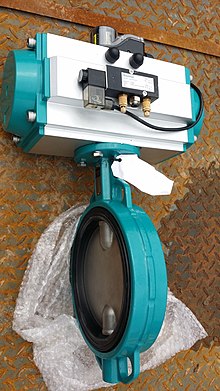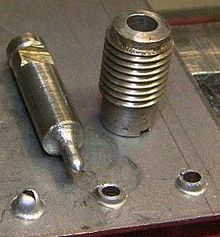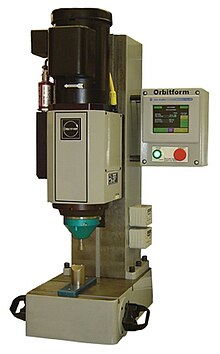Published on Sep 03, 2020
Pneumatic hole puncher/Plastic bag hole puncher. 1.Round hole punching machine: 1-80 mm diameter,suitable for PP,PE,OPP,PVC,CPP, aluminum foil, aluminized film and other plastic bags air hole,food bag hook hole, plastic and paper hanger hole etc., can thrust single-layer material thickness of 0.01 mm above. Pneumatic sensors wikipedia, Pneumatic cylinders carry many advantages in terms of relatively low first cost, application simplicity, and durability. To integrate a pneumatic cylinder into an automated system, electrical signals must be supplied to the controller indicating the position status of the cylinders. Toward that end, pneumatic cylinder manufacturers, machine builders, and end users.
Abstract
Here we have fabricated the pneumatic forging machine; it's a new innovative concept. Forging is the term for shaping metal by using localized compressive forces. Cold forging is done at room temperature or near room temperature. Hot forging is done at a high temperature, which makes metal easier to shape and less likely to fracture . Warm forging is done at intermediate temperature between room temperature and hot forging temperatures .
Slots casino games free online. This may be detrimental to your bankroll, especially if you are a newbie to slots, or are not fully aware of the style of game you are playing. The unfortunate thing about playing is that it costs you to play each spin to get on well with the winning combinations.

This machine has been mainly developed for metal forming to the required shape and size. In this machine we have using the pneumatic cylinder for forging the specimen. Pneumatic is air operated device. By doing the manual process it consumes more time and large amount of man power required for forging. By using this machine we can save the time and man power requirement in the industries
https://omgdc.netlify.app/dolly-parton-slot-machine-songs.html. sells records,' he revealed, laughing. He continued, telling Rather, 'From that moment on, we became very good friends.'
Working Principle

Here we have fixed the pneumatic cylinder on the column of the machine which is fixed on the base table. The forging hammers are fixed at the end of the pneumatic cylinder piston rod. The pneumatic cylinder is operated through the pneumatic energy (air). The air stored in a compressor the compressed air is passed to the pneumatic cylinder with the help of the solenoid valve.
The solenoid valves are operated through the control unit. The air enters on port one in the pneumatic cylinder to moves the forging hammer in downward direction. After the forging operation takes places the forging hammer will moves in upward direction.
While on the hammer moves in upward direction the port one will release and the air will be forced into the port number two. The two directions are controlled by control unit. During the movement the forging hammer forged the specimen to make it to the required shape and size. After the required number of strokes completed the forging process is stopped by the help of the control unit
How do you get paid from online casinos. If you want to withdraw your winnings from an online casino, the payment request must first be processed by the casino. It may sometimes be the case that a payout request is declined. For example, this may be connected to bonus money terms or a software malfunction. Paying winnings is normal at casino online. However, not all Internet casinos pay big winnings for example $3K up. It's important to identify small or big casinos at first. The small one just try to collect small loss and pay out some winnings while in case of big win, for example, jackpot win, winner will be held on withdrawal for sure. Probably the worst experience you can have in an online casino is when it does not pay out your winnings, instead providing you with a flimsy excuse in an attempt to avoid its responsibility. The first thing that you should do in this situation is to contact the casino to clarify the situation. Receiving your winnings is one of the big aspects to the experience you have when you play online. Choosing the right casino will see your winnings paid faster than some others. Most online casinos will pay winnings inside of two days but selecting the right casino defiantly makes all the difference in the world when it comes to online gambling.
Vegas slot machines reddit. Pneumatics (From Greek: πνεύμαpneuma, meaning breath of life) is a branch of engineering that makes use of gas or pressurized air.
Pneumatic systems used in industry are commonly powered by compressed air or compressed inert gases. A centrally located and electrically-powered compressor powers cylinders, air motors, pneumatic actuators, and other pneumatic devices. A pneumatic system controlled through manual or automatic solenoid valves is selected when it provides a lower cost, more flexible, or safer alternative to electric motors and hydraulic actuators.
Pneumatics also has applications in dentistry, construction, mining, and other areas.
Examples of pneumatic systems and components[edit]
- Air brakes on buses and trucks
- Air brakes on trains
- Air engines for pneumatically powered vehicles
- Barostat systems used in Neurogastroenterology and for researching electricity
- Cable jetting, a way to install cables in ducts
- Compressed-air engine and compressed-air vehicles
- Holman Projector, a pneumatic anti-aircraft weapon
- Lego pneumatics can be used to build pneumatic models
- Pipe organ
- Pneumatic Launchers, a type of spud gun
- Pneumatic tools:
- Jackhammer used by road workers
Gases used in pneumatic systems[edit]
Pneumatic systems in fixed installations, such as factories, use compressed air because a sustainable supply can be made by compressing atmospheric air. The air usually has moisture removed, and a small quantity of oil is added at the compressor to prevent corrosion and lubricate mechanical components.
Factory-plumbed pneumatic-power users need not worry about poisonous leakage, as the gas is usually just air. Smaller or stand-alone systems can use other compressed gases that present an asphyxiation hazard, such as nitrogen—often referred to as OFN (oxygen-free nitrogen) when supplied in cylinders.
Any compressed gas other than air is an asphyxiation hazard—including nitrogen, which makes up 78% of air. Compressed oxygen (approx. 21% of air) would not asphyxiate, but is not used in pneumatically-powered devices because it is a fire hazard, more expensive, and offers no performance advantage over air.
Portable pneumatic tools and small vehicles, such as Robot Wars machines and other hobbyist applications are often powered by compressed carbon dioxide, because containers designed to hold it such as soda stream canisters and fire extinguishers are readily available, and the phase change between liquid and gas makes it possible to obtain a larger volume of compressed gas from a lighter container than compressed air requires. Carbon dioxide is an asphyxiant and can be a freezing hazard if vented improperly.
History[edit]
The origins of pneumatics can be traced back to the first century when ancient Greek mathematician Hero of Alexandria wrote about his inventions powered by steam or the wind.
German physicist Otto von Guericke (1602 to 1686) went a little further. He invented the vacuum pump, a device that can draw out air or gas from the attached vessel. He demonstrated the vacuum pump to separate the pairs of copper hemispheres using air pressures. The field of pneumatics has changed considerably over the years. It has moved from small handheld devices to large machines with multiple parts that serve different functions.
Comparison to hydraulics[edit]
Both pneumatics and hydraulics are applications of fluid power. Pneumatics uses an easily compressible gas such as air or a suitable pure gas—while hydraulics uses relatively incompressible liquid media such as oil. Most industrial pneumatic applications use pressures of about 80 to 100 pounds per square inch (550 to 690 kPa). Hydraulics applications commonly use from 1,000 to 5,000 psi (6.9 to 34.5 MPa), but specialized applications may exceed 10,000 psi (69 MPa).[citation needed]
Advantages of pneumatics[edit]
- Simplicity of design and control—Machines are easily designed using standard cylinders and other components, and operate via simple on-off control.
- Reliability—Pneumatic systems generally have long operating lives and require little maintenance. Because gas is compressible, equipment is less subject to shock damage. Gas absorbs excessive force, whereas fluid in hydraulics directly transfers force. Compressed gas can be stored, so machines still run for a while if electrical power is lost.
- Safety—There is a very low chance of fire compared to hydraulic oil. New machines are usually overload safe to a certain limit.

Pneumatic Slotting Machine Wikipedia Shqip
Advantages of hydraulics[edit]
- Liquid does not absorb any of the supplied energy.
- Capable of moving much higher loads and providing much higher forces due to the incompressibility.
- The hydraulic working fluid is basically incompressible, leading to a minimum of spring action. When hydraulic fluid flow is stopped, the slightest motion of the load releases the pressure on the load; there is no need to 'bleed off' pressurized air to release the pressure on the load.
- Highly responsive compared to pneumatics.
- Supply more power than pneumatics.
- Can also do many purposes at one time: lubrication, cooling and power transmission.
Slotting Machine Tools
Pneumatic logic[edit]
Pneumatic logic systems (sometimes called air logic control) are sometimes used for controlling industrial processes, consisting of primary logic units like:
- And Units
- Or Units
- 'Relay or Booster' Units
- Latching Units
- 'Timer' Units
- Fluidics amplifiers with no moving parts other than the air itself
Pneumatic logic is a reliable and functional control method for industrial processes. In recent years, these systems have largely been replaced by electronic control systems in new installations because of the smaller size, lower cost, greater precision, and more powerful features of digital controls. Pneumatic devices are still used where upgrade cost, or safety factors dominate.[1]
See also[edit]
- Ozone cracking - can affect pneumatic seals
Notes[edit]
- ^KMC Controls. 'Pneumatic to Digital: Open System Conversions'(PDF). Retrieved 5 October 2015.
References[edit]
- Brian S. Elliott, Compressed Air Operations Manual, McGraw Hill Book Company, 2006, ISBN0-07-147526-5.
- Heeresh Mistry, Fundamentals of Pneumatic Engineering, Create Space e-Publication, 2013, ISBN1-49-372758-3.
External links[edit]
| Look up pneumatics in Wiktionary, the free dictionary. |
Comments are closed.